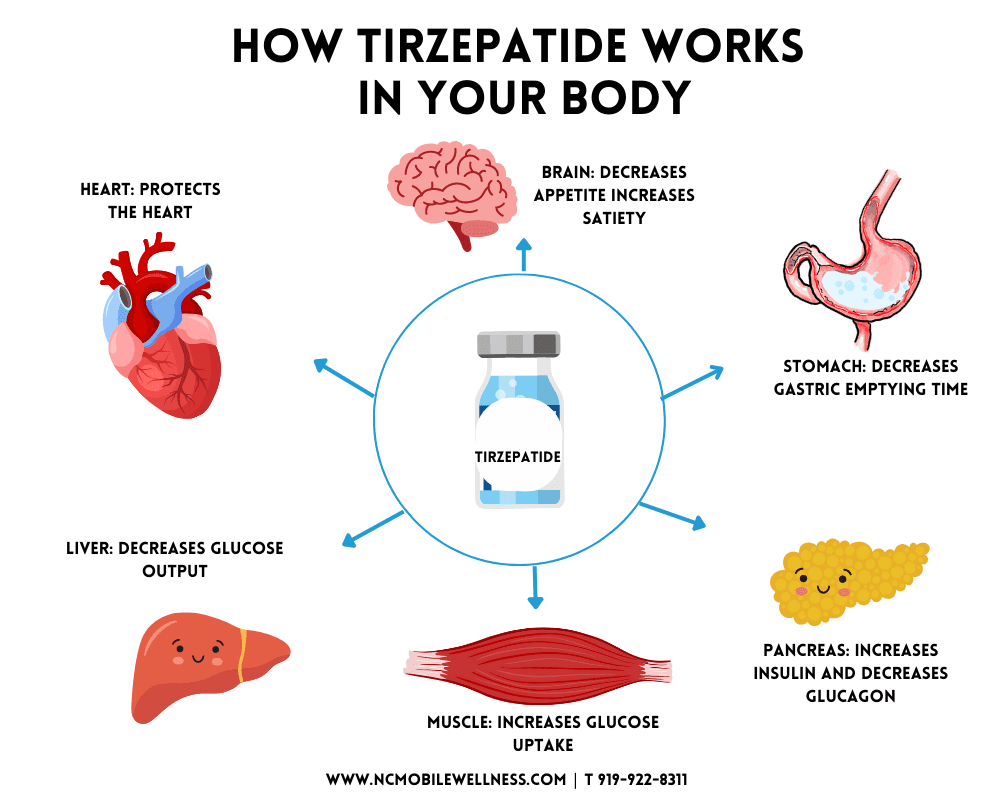Tirzepatide – How can weekly weight loss injections improve your weight loss journey?
Tirzepatide has shown promising weight loss results in patients! In a clinical trial, Tirzepatide demonstrated superior weight loss compared to a placebo over a 72-week treatment period. Participants taking Tirzepatide lost up to 15.7% of their body weight, with a significant percentage achieving at least a 5% reduction in body weight.
According to the study, the safety profile for Tirzepatide is generally comparable to other medications approved for weight loss treatment.

What Does Tirzepatide Do?
Tirzepatide is a prescription medication that acts as a GIP and GLP-1 receptor agonist. Together, these effects can help control blood sugar levels, reduce appetite by slowing the digestive process, and encourage weight loss.
An agonist is a medication that acts on a specific receptor to trigger a bodily response. In the case of GIP and GLP-1 agonists like Tirzepatide, they initiate the release of insulin.
Glucagon-like peptide-1 (GLP-1) is a hormone made up of 30 amino acids that comes from the endocrine cells in the intestines. It belongs to a group of hormones called incretins, which help increase insulin production. Glucose-dependent insulinotropic polypeptide (GIP) is another incretin that impacts insulin production.
Tirzepatide’s dual action as a GIP and GLP-1 agonist differentiates it from similar medications like Semaglutide. Some patients find that Tirzepatide provides stronger weight loss effects with fewer adverse effects like nausea.
How long does Tirzepatide take to start working?
Tirzepatide influences insulin production as soon as you begin taking the medication. This can lead to benefits like slowed weight gain, reduced risk of developing type-2 diabetes, and less fatigue related to blood sugar spikes throughout the day.
Despite working quickly on insulin, it may take time to feel the effects of Tirzepatide.
Many patients report a suppressed appetite after their first dose, but some patients don’t experience this benefit until they’ve taken Tirzepatide for a month or more.
When you inject your dose, it takes around 24 hours for the medication to be fully absorbed, so the effects often begin the next day after injection.
When will I see the results?
Every patient’s experience with weight loss varies, so there is no set timeframe that applies to everyone.
How quickly you lose weight depends on factors like lifestyle habits, diet, activity level, age, and other medications you may be taking.
Most people who follow a healthy diet and exercise routine start noticing weight loss within one to two months of starting the medication. Anecdotally, weight loss may occur at lower doses before reaching the maximum dose, but significant weight loss is usually achieved at higher, sustained doses.
Regardless of when you begin to feel the effects, Tirzepatide and similar medications work best when used to encourage weight loss over time.
In the study we mentioned earlier, participants were given varying doses of Tirzepatide over the course of 72 weeks (18 months). The study participants who took 5 mg, 10 mg, or 15 mg of Tirzepatide lost an average of 15-21% of their body weight over that time.
Weight loss programs should aim for long-term results rather than quickly losing weight.
Rapid weight loss can lead to metabolic changes that make weight gain more common after patients stop trying to lose weight. Lifestyle changes are important in helping patients maintain their progress after they’ve reached their goal weight.
How much weight do you typically lose on tirzepatide?
While everyone’s experience is unique, many people have lost 15% or more of their starting body weight with tirzepatide.
A clinical trial of over 2,500 people experienced significant weight loss in the first of tirzepatide’s weight loss studies. Those treated with tirzepatide had an average weight loss of 15% to 20% of their starting body weight over 72 weeks (about 16.5 months). This worked out to an average weight loss of 34 lbs to 48 lbs. Those taking the placebo (an injection with no medication in it) only had an average of 3% weight loss.
What’s more, over a third of those taking the highest tirzepatide dose (15 mg per week) lost at least 25% of their starting body weight (over 58 lbs).

How should Tirzepatide be administered?
Tirzepatide is typically administered once weekly as a subcutaneous injection. The medication should be started at a lower dose and increased over time. This helps patients avoid more intense side effects because titrating lets the body adjust over time.
Slim180 guides how to self-administer injections, as well as providing the necessary supplies like syringes and alcohol wipes.
How does tirzepatide cause weight loss?
Tirzepatide is thought to promote weight loss by decreasing your appetite and prolonging feelings of fullness. That’s because these effects can cause you to eat fewer calories.
Tirzepatide is unique because it’s the first combination of two classes of medications: a glucagon-like peptide-1 (GLP-1) receptor agonist and a glucose-dependent insulinotropic polypeptide (GIP) receptor agonist. Therefore, tirzepatide is known as a dual GLP-1/GIP receptor agonist.
GLP-1 and GIP are both incretin hormones, which are hormones that are released after eating. Tirzepatide works by mimicking their effects. This includes telling the pancreas to release insulin after eating and signaling the liver to lower the amount of glucose it’s making. These effects help lower blood glucose.
In addition to helping lower blood glucose, tirzepatide helps with weight loss in a couple of ways:
- It signals to the brain that you’re full — so you eat less.
- It slows the movement of food through your stomach — so you feel full longer.
Other similar injectable weight loss medications only mimic one incretin — GLP-1. It’s thought that because tirzepatide acts like two incretins, it can cause more weight loss than current alternatives. Researchers have studied how effective tirzepatide is for weight loss — for people with and without diabetes.

DRUG INTERACTIONS
If you’re starting Tirzepatide, drug interactions might not have been the first question to come to mind. It’s important to know if it’s safe to combine with other medications you may take. Many interactions involve a drop in your blood glucose (hypoglycemia). But Tirzepatide can also potentially interfere with oral medications, including birth control pills. Let’s review five important Tirzepatide drug interactions you should know about.
1. Insulin
Some people with Type 2 diabetes take a combination of insulin and other diabetes medications, like Tirzepatide, to help manage their blood glucose. However, taking both Tirzepatide and insulin can raise the risk of hypoglycemia (blood glucose of less than 70 mg/dL). So extra caution is needed with this combination.
Watch for symptoms of hypoglycemia when taking Tirzepatide and insulin. These can include shakiness, sweating, and a fast heart rate. Hypoglycemia can be life-threatening in severe cases. So it’s important to treat it quickly if it happens to you.
To help prevent hypoglycemia, your healthcare provider may lower your dose of insulin when you first start Tirzepatide. Be sure to check your blood glucose as instructed by your provider and let them know if you start experiencing low glucose levels.
2. Sulfonylureas like glipizide
Sulfonylureas are a commonly prescribed group of oral diabetes medications. Examples include glipizide (Glucotrol XL), glyburide (Diabeta, Glynase), and glimepiride (Amaryl). Taking Tirzepatide and sulfonylureas can also raise the risk of hypoglycemia.
Like Tirzepatide, sulfonylureas signal your pancreas to release insulin. The difference is that sulfonylureas tell your pancreas to release insulin whether you’ve eaten or not. Taking a sulfonylurea and Tirzepatide together may lead to the release of too much insulin. This can cause hypoglycemia.
As with insulin, Tirzepatide and sulfonylureas can still be taken together, if needed. Your healthcare provider may lower your sulfonylurea dose before you start Tirzepatide. Be sure to let them know of any drops in glucose that happen after starting the combination, or after dose increases.
3. Glinides like repaglinide
Meglitinides (“glinides”) are a less popular group of oral diabetes medications. Examples of glinides include repaglinide and nateglinide. Like sulfonylureas, they tell your pancreas to release insulin. But glinides work faster and their effects are shorter-lived than sulfonylureas.
Similar to the medications listed above, taking Tirzepatide and a glinide together can raise the risk of hypoglycemia. If your healthcare provider prescribes both medications for you, they’ll likely adjust your glinide dose when first starting Tirzepatide. Let your provider know if you start experiencing low glucose levels more frequently after starting both medications.
4. Birth control pills
Tirzepatide can make birth control pills less effective, especially when first starting Tirzepatide or after dose increases. This can lead to unintended pregnancies or a return of symptoms you’re taking birth control to help manage.
This Tirzepatide drug interaction happens because of how the medication works. Tirzepatide slows down the movement of food from your stomach to the small intestine. Food that’s delayed in the stomach prevents spikes in your blood glucose and makes you feel full faster and for longer.
A downside to slower digestion is that it can affect how oral birth control is absorbed from your digestive tract. This could mean less medication is absorbed than what’s supposed to be, potentially causing birth control to be less effective. This interaction is most significant when first starting Tirzepatide, and shortly after any dose increases.
Tirzepatide can also cause several stomach-related side effects, such as vomiting and diarrhea. Vomiting shortly after a dose of birth control can prevent proper absorption. Diarrhea — particularly diarrhea that continues for 2 days or longer — can also prevent full absorption.
Non-oral methods of birth control, such as the patch or ring, may be a better option, as they’re not affected by Tirzepatide. You can also use a barrier method, such as condoms. These alternative birth control options should be used for the first 4 weeks after starting Tirzepatide and for 4 weeks anytime your dose increases.
5. Other oral medications
Delayed stomach emptying can also affect the absorption of other oral medications, similar to Tirzepatide’s interaction with birth control pills.
This may be concerning if you take medications that are highly sensitive to small changes in dose, like warfarin. Warfarin can cause serious side effects, like blood clots or bleeding, even when slight changes in its levels happen. Your healthcare provider may recommend monitoring your blood work more frequently when you start Tirzepatide.
Your healthcare provider or pharmacist can tell you if any medications you take are sensitive to small dose changes. They can also provide you with information on the best way to manage this Tirzepatide interaction.
